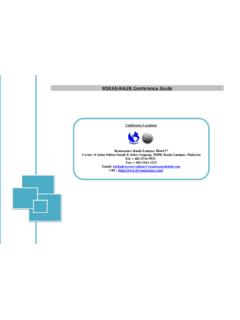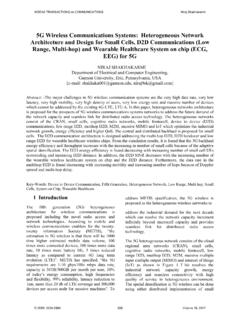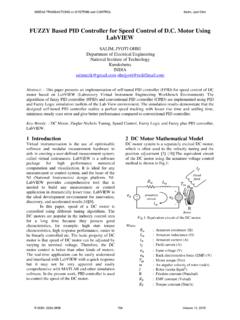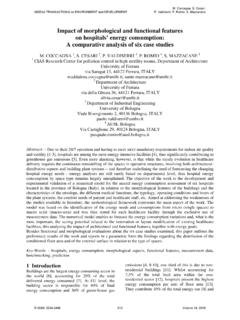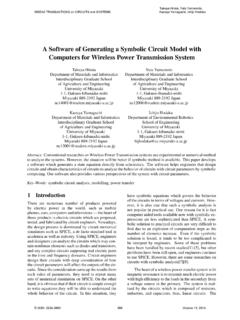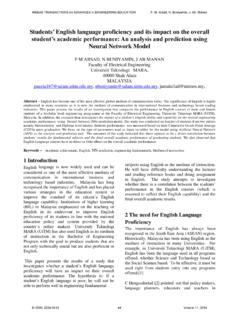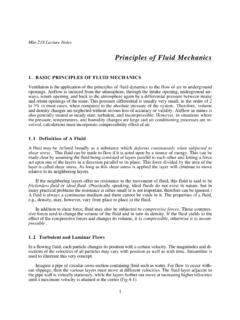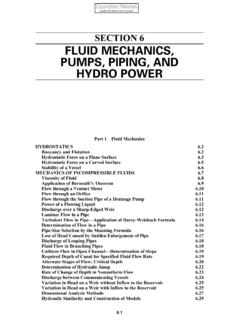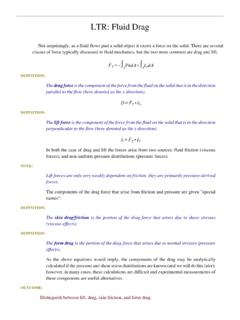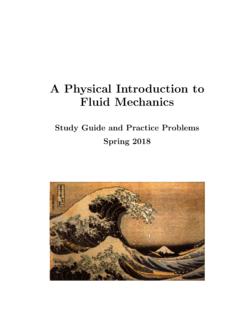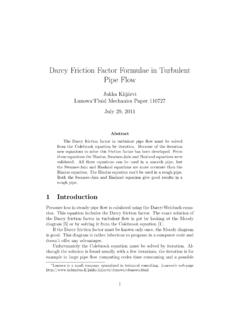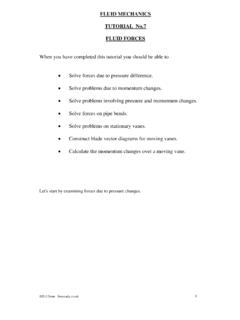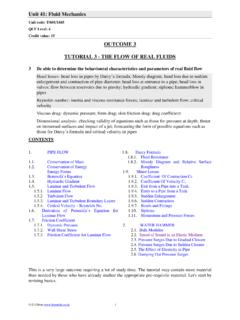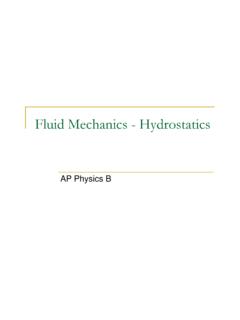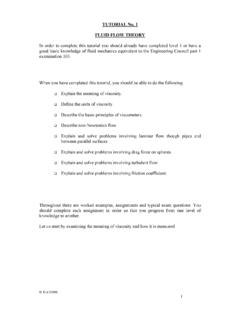Transcription of The Effect of Internal Profile on Cannula Outflow - wseas.org
1 The Effect of Internal Profile on Cannula Outflow NADIA SHAIRA SHAFII1, NOFRIZALIDRIS DARLIS2, JESWANT DILLON3, KAHAR OSMAN1,2, AHMAD ZAHRAN MD KHUDZARI1, 1 IJN UTM Cardiovascular Engineering Center, Faculty of Biosciences and Medical Engineering, 2 Faculty of Mechanical Engineering, Universiti Teknologi Malaysia, 81310 Skudai, Johor, MALAYSIA 3 Institut Jantung Negara (IJN), Kuala Lumpur, Malaysia Abstract: - One of the medical devices used during the open heart surgery in cardiopulmonary bypass (CPB) is the aortic curve-tip Cannula . The aortic curve-tip Cannula is also used in the extracorporeal membrane oxygenator (ECMO) to support patient in intensive care unit.
2 There are few complications caused by the non physiological jet or dispersed flow from the current Cannula design. Thus, a novel designs approach to induce spiral flow and reduce the adverse Effect on the aortic wall. The objective of this study is to compare the Internal helical designs of curved-tip aortic Cannula from three groove Internal Cannula design and three ribs Internal Cannula design against the standard Cannula design; all with variation of straight and tapered body. A comparative study between six cannulae designs were carried out by computational fluid dynamics (CFD) in a steady state condition.
3 Alls proposed Internal helical designs have successfully induced spiral flow. The tapered body with 3 rib design was the best curved-tip aortic Cannula design, since wall shear stress induced (2310 dyne/cm2) was below the critical value of wall shear stress (4500 dyne/cm2); while the Outflow velocity was only slightly more than the standard Cannula design. Also, the pressure drop across the Cannula (66 mmHg) was significantly below the safe limit (100 mmHg). Key-Words: - - spiral flow, aortic Cannula design, Internal helical design aortic curved-tip Cannula , computational fluid dynamics, cardiopulmonary bypass.
4 1 Introduction Aortic curved-tip Cannula is a catheter device which is inserted in the aorta function to deliver the oxygenated blood from the heart lung machine (HLM) during the open heart surgery [1]. However, due to the non physiological Outflow pattern from current cannulae, there are some adverse effects detected such as sand blasting Effect , hemolytic damaged and cerebral haemorrhage [2]. Furthermore, the current Cannula design is unable to induce the physiological spiral flow in the aorta [4]. The design of the Cannula affects the hydrodynamics condition of the Outflow where a typical standard Cannula design produces high velocity flow upon exiting the tip into the aorta.
5 Plaque rupture formation or sand blasting Effect are also by the high Outflow velocity of the single stream jetting, even the multiple jets Outflow from the curved-tip Cannula [3,5]. In order to reduce the Outflow velocity, there are few types of Cannula designs established such as soft type flow Cannula pattern and also dispersion type Cannula pattern [5]; unfortunately all of them are unable to induce the physiological spiral flow pattern. Despite inducing lower Outflow velocity, among the flow stream pattern, large vortices were still present at the aortic [5].
6 Another commonly used Cannula design is the end hole Cannula since it induce low forces and Outflow velocity [3]. The formation of thromboembolism and hemodynamic Effect is influenced by the Cannula jetting Outflow condition [5]. A hypothesis was formed saying that the unstable hemodynamic corresponds to lower velocity, unstable range of wall shear stress [2]. We are proposing that by inducing Internal helical spiral in the Cannula , the exit velocity and the sandblasting Effect can be reduced. If the physiological flow Profile within the aorta can be maintained or induced, then the impact to the patient during surgical operation using the cardiopulmonary bypass (CPB), as well as extra corporeal membrane oxygenator (ECMO) will be positive[9].
7 WSEAS TRANSACTIONS on FLUID MECHANICSE-ISSN: 2224-347X187 Volume 9, 2014 Nadia Shaira Shafii, Nofrizalidris Darlis, Jeswant Dillon, Kahar Osman, Ahmad Zahran Md Khudzari Thus, helical Internal spiral curve-tip designs are proposed in this paper to investigate the Effect of the design on the blood flow condition. Comparison between the spiral design and the standard design was made to determine any improvements of inducing spiral flow. Numerical analysis was conducted to compare and evaluate the merits of the spiral and design in a steady state flow condition. Attention was given to the flow characteristics by virtue of the spiral flow inducing design feature, such as pressure drop within the cannulae, Outflow velocity at the test rig, flow pattern, and also the helicity density in order to confirm that the proposed designs managed to induce the physiological flow Profile of blood in aorta.
8 2 Methodology There are several studies relates to the blood characteristics and behavior using the Computational Fluid Dynamics (CFD) method [19, 20, 21]. Thus, CFD was employed to simulate flow inside a straight tube as a simplified blood wall vessel connected to selected cannulae designs in this study. Geometry: Models Geometry The cannulae were modeled into six different designs: straight body Cannula design (standard design), tapered body Cannula design (standard tapered design), a spiral profiled straight body Cannula with 3 groove, a spiral Profile tapered body Cannula with 3 groove, a spiral profiled straight body Cannula with 3 ribs and a spiral profiled tapered body Cannula with 3 ribs as illustrated in Fig.
9 2. Fig 1 shows the differences between the rib and groove Internal helical designs. A simple rigid tube wall vessel connected to each of the curve-tip Cannula models. The simple rigid tube wall vessel represents the aorta with Internal diameter 25 mm and 200 mm length [10]. The parameters of the proposed design are listed in the Table 1, for the straight body and for the tapered body in Table 2. Table 1 The parameters of proposed Internal spiral aortic straight body Cannula design. Geometrical properties Curve-tip standard Cannula Cannula length 250mm Internal diameter 8mm [24 Fr] External diameter 10mm Spiral length 90mm Spiral pitch, revolution 30,3 Table 2 The parameters of proposed Internal spiral aortic tapered body Cannula design.
10 Geometrical properties Curve-tip standard Cannula Cannula length 250mm Internal diameter 10 - 8mm [24 Fr] External diameter 13 - 10mm Spiral length 90mm Spiral pitch, revolution 30,3 To ensure that the existence of spiral flow induced by the proposed designs, a detailed numerical simulation was done to analyse the output flow structure Profile and attention is given at the tip of the curved Cannula where different types of Internal Profile design will affect the Outflow . As shown in Fig. 2, all of the curved-tip Cannula designs are intended for adult physiology (24F). The standard Cannula was used as control design where the general dimension setup of the proposed design Profile was based upon.

